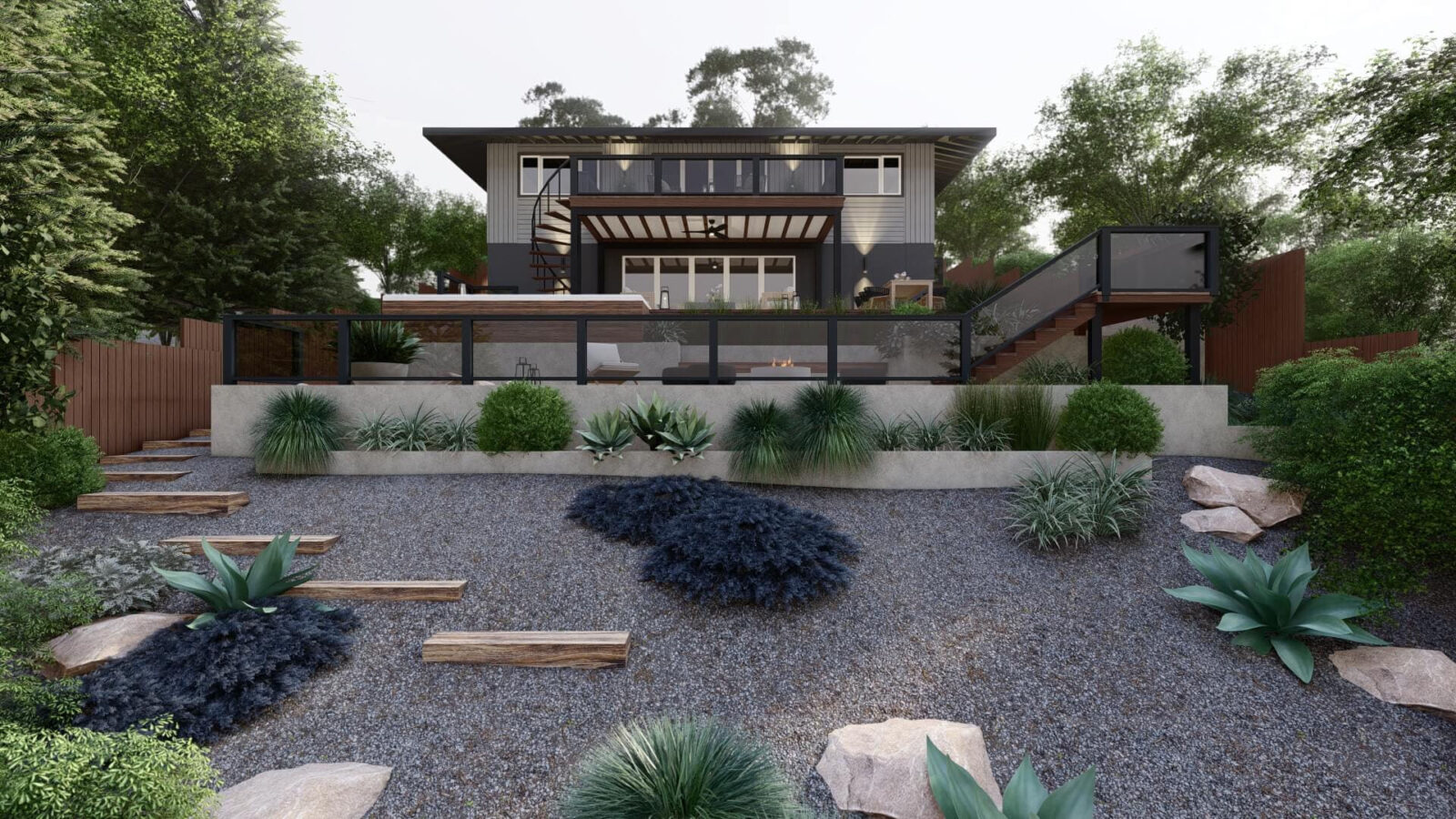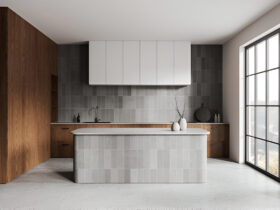Landscaping a sloped yard can feel overwhelming, as uneven ground often leads to problems such as erosion, inadequate drainage, and reduced functionality. But with the right strategy, you can transform a sloped outdoor space into a beautifully designed, functional, and sustainable landscape.
Whether you’re planning a garden makeover or building a new outdoor area, this guide will help you discover smart landscaping solutions for slopes turning those challenging grades into eye-catching features.
Challenges of Landscaping on a Slope
Before jumping into design ideas, it’s essential to understand the unique challenges that sloped landscapes present:
- Erosion and Water Runoff: Rainwater flows more quickly down slopes, washing away topsoil and nutrients.
- Soil Stability: It’s harder to retain moisture and keep plants rooted on a steep incline.
- Maintenance Issues: Mowing, watering, and pruning can become difficult and sometimes dangerous.
- Limited Use: Flat surfaces are ideal for patios, lawns, or play areas—none of which come naturally on a slope.
Addressing these issues requires thoughtful design, proper plant choices, and sometimes structural solutions.
Evaluate Your Slope Before You Start
Every slope is different, so start by evaluating the specific characteristics of your landscape before beginning any work. Proper assessment will help you choose the right solutions and avoid costly missteps.
Check the Slope Gradient
- Gentle slopes (under 10%) may only need minor grading.
- Steeper slopes (above 20%) require terracing or structural support.
Understand Your Soil Type
- While sandy soil allows quick drainage, it often struggles to hold onto moisture.
- Clay soils can become compacted and poorly drained.
Assess Drainage Patterns
- Observe where water flows after rain and look for puddles or erosion paths.
Sun and Shade Exposure
- South-facing slopes in the northern hemisphere get more sun and dry out faster.
- Shade-loving plants work better on cooler, north-facing slopes.
Before diving into your design plans, it’s smart to take a step back and evaluate the groundwork. Considering the slope gradient, soil conditions, and light exposure is only part of the puzzle. Taking time to review these things before a major landscaping makeover can help you make informed decisions and ensure your project starts off on the right foot.
Smart Solutions for Sloped Landscapes
Designing on a slope requires a creative and cost-effective approach. From strategic planting to structural enhancements, the key is to blend functionality with beauty. If you’re looking for ideas that balance aesthetics and budget, exploring affordable landscaping strategies can offer practical inspiration for making the most of your sloped yard.
1. Terracing for Structure and Usability
For managing steep slopes, terracing remains among the most reliable methods. It involves building a series of level platforms or steps into the slope using retaining materials like:
- Stone
- Concrete blocks
- Timber
Benefits:
- Controls erosion
- Creates usable planting or seating areas
- Adds visual interest with multi-level gardens
Terracing works best when done in harmony with natural slope contours. Professional landscaping services can help ensure structural safety and long-term durability.
2. Retaining Walls: Support with Style
Retaining walls are essential for stabilizing soil and preventing erosion on moderate to steep slopes. Various kinds of retaining walls are available to choose from:
- Gravity walls use their own mass to resist soil pressure.
- Cantilevered walls: Use a structural base underground
- Segmental walls: Modular and flexible for DIY projects
Use materials like natural stone for a rustic look, or concrete blocks for modern appeal. Always include proper drainage behind the wall to reduce hydrostatic pressure.
3. Planting the Right Way
Choosing the right plants for a sloped landscape is more than just a design decision—it’s a key step in preventing erosion and promoting long-term stability. Deep-rooted, drought-tolerant plants are ideal for anchoring the soil while also enhancing the visual appeal of your outdoor space.
Recommended Plant Types for Slopes:
- Groundcovers: Such as creeping juniper, ice plant, and vinca minor, which spread quickly and help hold the soil.
- Ornamental Grasses: Like blue fescue and fountain grass, which offer texture and wind resistance.
- Low-Maintenance Shrubs: Lavender, rosemary, and dwarf sumac are hardy and require minimal upkeep.
- Small Trees: Species like redbud or dwarf evergreens provide structure without overwhelming the space.
When planning your layout, group plants by sun and water needs and use staggered planting techniques to maximize root coverage. Mulching around the base of plants helps conserve moisture and suppress weeds important on slopes where water drains quickly.
For optimal results, working with experienced landscaping professionals can ensure you select plant varieties that are not only beautiful but also suited to your soil conditions, slope angle, and climate. Their expertise can make all the difference in creating a slope garden that thrives season after season.
4. Erosion Control Techniques
To minimize the impact of water runoff, consider adding:
- Mulch: Retains moisture and prevents topsoil erosion
- Jute netting or coir logs: Hold soil in place during plant establishment
- Dry creek beds help direct excess water flow while enhancing the landscape’s appearance.
- Swales and rain gardens: Direct runoff into a slow-absorbing planted area
These strategies help control both visible and hidden water damage, especially after heavy rains.
5. Stairs, Paths & Access Routes
Navigating a sloped yard safely and comfortably is just as important as aesthetics. Add:
- Stone or wooden steps: Natural-looking and slip-resistant
- Meandering paths: Follow the contour of the slope with gravel, bricks, or stepping stones
- Handrails and lighting: Improve nighttime visibility and safety
Use pathways to guide movement and connect different levels in your landscape.
Design Inspiration Ideas for Sloped Yards
- Tiered Garden Beds: Combine vegetables, herbs, and flowers on different levels.
- Hillside Seating Area: A bench built into a terrace wall or a fire pit platform.
- Wildflower Meadow: A low-maintenance slope filled with native wildflowers.
- Dry Waterfall Garden: Use stones, pebbles, and drought-friendly plants to mimic water flow.
- Fruit Tree Grove: Grow dwarf fruit trees that thrive with the improved drainage provided by sloped land.
These creative ideas show that sloped yards can be just as exciting—and sometimes even more rewarding than flat ones.
Maintenance Tips for Sloped Landscapes
- Inspect regularly: After rains, check for signs of erosion or drainage issues.
- Apply fresh mulch each season to help cool the soil and suppress weeds.
- Prune plants to control spread: Especially groundcovers.
- Keeping pathways and steps free of debris helps prevent slip-related accidents.
- Check walls for cracking or shifting, particularly in clay-heavy soils.
Routine care goes a long way in keeping your sloped yard healthy and functional year-round.
When to Call in the Pros
While many homeowners take the DIY route, some slope conditions are best handled by professionals. You should consult a landscaping expert if:
- The slope is steeper than 20%
- There are signs of major soil erosion or instability
- Retaining walls or drainage systems are needed
- You want to integrate advanced hardscape features
Professionals can help design and execute a plan that matches your vision and site conditions while ensuring safety and sustainability.
Conclusion
Landscaping on a slope doesn’t have to be a problem. With smart planning, the right materials, and thoughtful plant choices, you can transform your sloped yard into a stunning outdoor haven. Whether you’re looking to create garden beds, control erosion, or build beautiful terraces, there’s a solution for every landscape.
Don’t let uneven terrain limit your creativity embrace it. With the right approach and expert help where needed, your slope can become the most dynamic part of your entire landscape.











Leave a Review